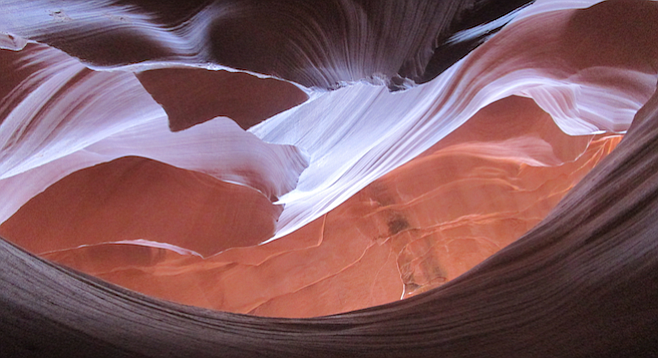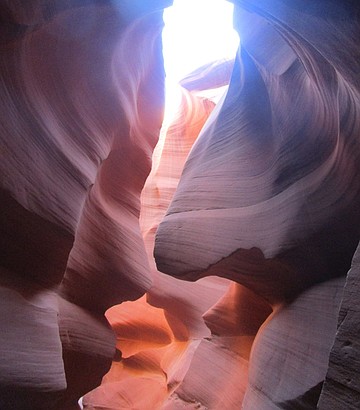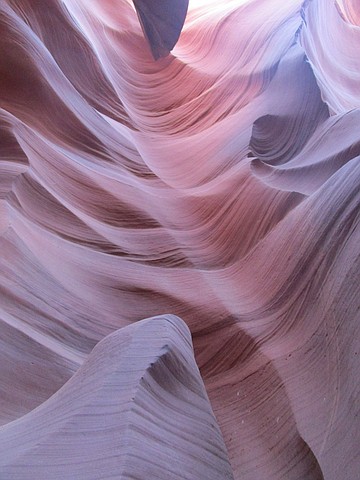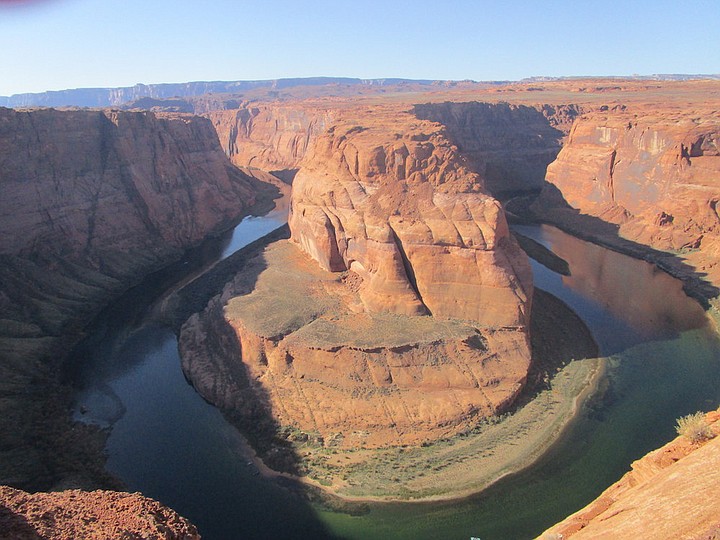 Facebook
Facebook
 X
X
 Instagram
Instagram
 TikTok
TikTok
 Youtube
Youtube

Nestled about halfway between Zion National Park and the Grand Canyon, Page, Arizona, has some knock-your-eyes-out-jaw-dropping natural phenomena of its own.
A small, nondescript town in northern Arizona, Page highlights its proximity to Antelope Canyon and Horseshoe Bend, both located within a short drive of town.

I had no inkling of the existence of Antelope Canyon for most of my life on the West Coast, even though I had visited Arizona many times.
I recently gained an awareness and appreciation of the canyon when I became entranced by some stunning photos on Instagram. The play of light over the unusual rock patterns and formations was unlike anything I had seen before. How had I not heard of this place? I determined that I had to visit. Finally, with plans made and my curiosity and anticipation piqued, I was even more excited about coming here than I was about revisiting Zion National Park, possibly my favorite spot in the country.
On a crisp, clear November day, I finally had my opportunity to visit the Lower Canyon. Located within Navajo Nation, the tours into the canyon are led by Navajo guides. Our group of about 15 walked down to the canyon through an Arizona desert landscape. Several other groups left at 15-minute intervals, each with their own guide.
Our guide was friendly and informative, pointing out some dinosaur footprints along the way and keeping us informed as to what to expect.
After about a half-mile walk, we descended some pre-installed ladders into the Lower Canyon. “Don’t take pictures while walking down the ladders,” our guide warned us. “People have fallen.”
This didn't surprise me a bit. The state one might experience upon encountering the play of sunlight beams over the rock formations could easily cause a temporary disorientation from one’s bearings and personal safety, resulting in, well... you get the idea. But don’t let that dissuade you from coming, unless you have difficulty with stairs or are susceptible to vertigo.
Once inside the canyon on the flat, sandy floor, hordes of visitors look around, immersed in the enchantments of the smooth sandstone rocky wonderland and snapping photos in every direction. (Antelope Canyon is not the place to come for a sense of solitude!)
I quickly realized why this is the most photographed slot canyon in the world. The sandstone sculptures look like something you'd encounter on another planet. The guide made some suggestions of where to look, but it’s not clear where the most photogenic shot is and you don’t want to fritter away the limited time allotted. You might just want to start shooting everything in sight.

Despite the crowd and hubbub, it’s fun to try to find an angle or perspective that particularly appeals to you. It’s also a great spot for selfie freaks. One’s creative juices are easily stimulated here.
Our guide helped us adjust our cameras for the best setting: Chrome. He spoke of how the canyon was relatively unknown and ignored by travelers until a prominent National Geographic article emerged in the 90’s. With the popularity of Instagram, the canyon is now a worldwide phenomenon — underscored by the fact that on the day I visited, most of our group consisted of Chinese tourists.
Despite the exhilaration of being in the canyon, we were reminded that there was once a tragic incident here. A 1997 flash flood trapped and drowned 11 visitors. Since then, visitors have been required to go down into both canyons with a Navajo guide. There is little time to escape in the event of a flash flood, so attention should be paid to weather conditions. Flash floods actually contributed greatly to the formation of the canyon through sandstone erosion.
On a visit to Antelope Canyon, you must choose between visiting the upper or lower canyon. Lower Canyon is less visited and cheaper, while Upper Canyon is more crowded and has longer walkways. If you have mobility issues and/or are looking for the most spectacular photos, go with Upper Canyon. The best time to visit the Upper Canyon is probably the summer, when light beams have their strongest effect.
In the Lower Canyon, where I visited, morning seems to be the best time of day. I’m told the best light beams are usually between 10 and 12. Shots with the pouring sand in Upper Canyon are particularly mystical. In retrospect, I wish I had seen Upper Canyon. Now I have something to go back for!

Horseshoe Bend is also a must-see for anyone visiting Page. The parking area is just off the Highway 89 leading out of Page. Bring water, sunscreen, a hat and, of course, a camera. A short hike (about ¾ of a mile) leads one to an enormous hole in the earth with a rock formation nearly encircled by water, shaped something like a horseshoe. The effect is jarring; I was overcome by a feeling of awe. The best times to visit here are sunrise and sunset, and it’s best to avoid coming here in the middle of the day.
While enjoying the breathtaking view, my attention was diverted to a visitor who was moving a little too quickly and casually near the edge of the cliff. There is no guardrail here, and one errant move would send him hurtling into the abyss. After my visit, I Googled Horseshoe Bend deaths to see if that grisly fate had befallen anyone. Sure enough, just a few years ago, a young man visiting from Greece with his family was acting similarly to this guy. The man’s family frantically waved at him to move away from the dangerous edge, but to no heed. He lost his footing and fell nearly 600 feet to his death.
No need to be a showoff here and risk your life for a frickin’ selfie. Just admire the view! It’s awe-inspiring and perfectly safe if you’re sensible.
Antelope and Horseshoe can both be easily accessed in a day, but it’s highly recommended to reserve your visit to Antelope Canyon online. Tourism related to the canyon has been a source of income for the Navajo Nation for years. Both Upper and Lower Canyon require separate visits and separate reservations. Lower Canyon Tours and Ken’s Tours accept online reservations for the lower canyon.
My visits to Horseshoe Bend and Antelope Canyon were enough to make the drive from Zion to Page worthwhile for me. But there are other attractions in the area aside from these two standouts: Lake Powell is one of the largest manmade lakes in the U.S. and a popular camping site. The Glen Canyon National Recreation Area is a gorgeous area worth exploring.
Also, a 20-minute drive from Page will bring you to the Grand Staircase-Escalante National Monument, which is world-renowned for its dinosaur finds. To sum up, if you’re visiting Zion or the Grand Canyon, or just passing through northern Arizona, a side trip to Page is certainly worth it.


Nestled about halfway between Zion National Park and the Grand Canyon, Page, Arizona, has some knock-your-eyes-out-jaw-dropping natural phenomena of its own.
A small, nondescript town in northern Arizona, Page highlights its proximity to Antelope Canyon and Horseshoe Bend, both located within a short drive of town.

I had no inkling of the existence of Antelope Canyon for most of my life on the West Coast, even though I had visited Arizona many times.
I recently gained an awareness and appreciation of the canyon when I became entranced by some stunning photos on Instagram. The play of light over the unusual rock patterns and formations was unlike anything I had seen before. How had I not heard of this place? I determined that I had to visit. Finally, with plans made and my curiosity and anticipation piqued, I was even more excited about coming here than I was about revisiting Zion National Park, possibly my favorite spot in the country.
On a crisp, clear November day, I finally had my opportunity to visit the Lower Canyon. Located within Navajo Nation, the tours into the canyon are led by Navajo guides. Our group of about 15 walked down to the canyon through an Arizona desert landscape. Several other groups left at 15-minute intervals, each with their own guide.
Our guide was friendly and informative, pointing out some dinosaur footprints along the way and keeping us informed as to what to expect.
After about a half-mile walk, we descended some pre-installed ladders into the Lower Canyon. “Don’t take pictures while walking down the ladders,” our guide warned us. “People have fallen.”
This didn't surprise me a bit. The state one might experience upon encountering the play of sunlight beams over the rock formations could easily cause a temporary disorientation from one’s bearings and personal safety, resulting in, well... you get the idea. But don’t let that dissuade you from coming, unless you have difficulty with stairs or are susceptible to vertigo.
Once inside the canyon on the flat, sandy floor, hordes of visitors look around, immersed in the enchantments of the smooth sandstone rocky wonderland and snapping photos in every direction. (Antelope Canyon is not the place to come for a sense of solitude!)
I quickly realized why this is the most photographed slot canyon in the world. The sandstone sculptures look like something you'd encounter on another planet. The guide made some suggestions of where to look, but it’s not clear where the most photogenic shot is and you don’t want to fritter away the limited time allotted. You might just want to start shooting everything in sight.

Despite the crowd and hubbub, it’s fun to try to find an angle or perspective that particularly appeals to you. It’s also a great spot for selfie freaks. One’s creative juices are easily stimulated here.
Our guide helped us adjust our cameras for the best setting: Chrome. He spoke of how the canyon was relatively unknown and ignored by travelers until a prominent National Geographic article emerged in the 90’s. With the popularity of Instagram, the canyon is now a worldwide phenomenon — underscored by the fact that on the day I visited, most of our group consisted of Chinese tourists.
Despite the exhilaration of being in the canyon, we were reminded that there was once a tragic incident here. A 1997 flash flood trapped and drowned 11 visitors. Since then, visitors have been required to go down into both canyons with a Navajo guide. There is little time to escape in the event of a flash flood, so attention should be paid to weather conditions. Flash floods actually contributed greatly to the formation of the canyon through sandstone erosion.
On a visit to Antelope Canyon, you must choose between visiting the upper or lower canyon. Lower Canyon is less visited and cheaper, while Upper Canyon is more crowded and has longer walkways. If you have mobility issues and/or are looking for the most spectacular photos, go with Upper Canyon. The best time to visit the Upper Canyon is probably the summer, when light beams have their strongest effect.
In the Lower Canyon, where I visited, morning seems to be the best time of day. I’m told the best light beams are usually between 10 and 12. Shots with the pouring sand in Upper Canyon are particularly mystical. In retrospect, I wish I had seen Upper Canyon. Now I have something to go back for!

Horseshoe Bend is also a must-see for anyone visiting Page. The parking area is just off the Highway 89 leading out of Page. Bring water, sunscreen, a hat and, of course, a camera. A short hike (about ¾ of a mile) leads one to an enormous hole in the earth with a rock formation nearly encircled by water, shaped something like a horseshoe. The effect is jarring; I was overcome by a feeling of awe. The best times to visit here are sunrise and sunset, and it’s best to avoid coming here in the middle of the day.
While enjoying the breathtaking view, my attention was diverted to a visitor who was moving a little too quickly and casually near the edge of the cliff. There is no guardrail here, and one errant move would send him hurtling into the abyss. After my visit, I Googled Horseshoe Bend deaths to see if that grisly fate had befallen anyone. Sure enough, just a few years ago, a young man visiting from Greece with his family was acting similarly to this guy. The man’s family frantically waved at him to move away from the dangerous edge, but to no heed. He lost his footing and fell nearly 600 feet to his death.
No need to be a showoff here and risk your life for a frickin’ selfie. Just admire the view! It’s awe-inspiring and perfectly safe if you’re sensible.
Antelope and Horseshoe can both be easily accessed in a day, but it’s highly recommended to reserve your visit to Antelope Canyon online. Tourism related to the canyon has been a source of income for the Navajo Nation for years. Both Upper and Lower Canyon require separate visits and separate reservations. Lower Canyon Tours and Ken’s Tours accept online reservations for the lower canyon.
My visits to Horseshoe Bend and Antelope Canyon were enough to make the drive from Zion to Page worthwhile for me. But there are other attractions in the area aside from these two standouts: Lake Powell is one of the largest manmade lakes in the U.S. and a popular camping site. The Glen Canyon National Recreation Area is a gorgeous area worth exploring.
Also, a 20-minute drive from Page will bring you to the Grand Staircase-Escalante National Monument, which is world-renowned for its dinosaur finds. To sum up, if you’re visiting Zion or the Grand Canyon, or just passing through northern Arizona, a side trip to Page is certainly worth it.
Comments